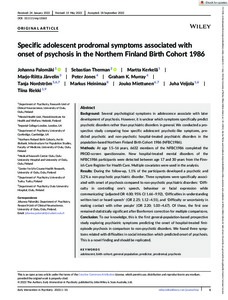Specific adolescent prodromal symptoms associated with onset of psychosis in the Northern Finland Birth Cohort 1986
Nordström Tanja; Heinimaa Markus; Murray Graham K; Jones Peter; Veijola Juha; Palomäki Johanna; Miettunen Jouko; Kerkelä Martta; Järvelin Marjo-Riitta; Therman Sebastian; Riekki Tiina
https://urn.fi/URN:NBN:fi-fe2022112967811
Tiivistelmä
Background: Several psychological symptoms in adolescence associate with later development of psychosis. However, it is unclear which symptoms specifically predict psychotic disorders rather than psychiatric disorders in general. We conducted a prospective study comparing how specific adolescent psychotic-like symptoms, predicted psychotic and non-psychotic hospital-treated psychiatric disorders in the population-based Northern Finland Birth Cohort 1986 (NFBC1986).
Methods: At age 15-16 years, 6632 members of the NFBC1986 completed the PROD-screen questionnaire. New hospital-treated mental disorders of the NFBC1986 participants were detected between age 17 and 30 years from the Finnish Care Register for Health Care. Multiple covariates were used in the analysis.
Results: During the follow-up, 1.1% of the participants developed a psychotic and 3.2% a non-psychotic psychiatric disorder. Three symptoms were specifically associated with onset of psychosis compared to non-psychotic psychiatric disorders: 'Difficulty in controlling one's speech, behaviour or facial expression while communicating' (adjusted OR 4.00; 95% CI 1.66-9.92), 'Difficulties in understanding written text or heard speech' (OR 2.25; 1.12-4.51), and 'Difficulty or uncertainty in making contact with other people' (OR 2.20; 1.03-4.67). Of these, the first one remained statistically significant after Bonferroni correction for multiple comparisons.
Conclusion: To our knowledge, this is the first general-population-based prospective study exploring psychiatric symptoms predicting the onset of hospital-treated first-episode psychosis in comparison to non-psychotic disorders. We found three symptoms related with difficulties in social interaction which predicted onset of psychosis. This is a novel finding and should be replicated.
Kokoelmat
- Rinnakkaistallenteet [19207]
